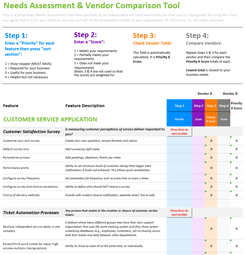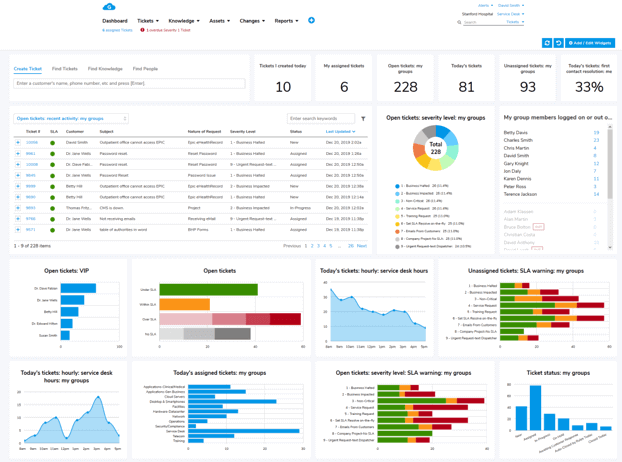Contact Center Analytics: What It Is and How to Use It Most Effectively
In our article, we help you understand what call center analytics is, the various types, and how to use it best and overcome challenges to take your processes to the next level.

What Is Contact Center Analytics?
Contact center analytics is the practice of collecting and interpreting data from customer interactions throughout the various touchpoints of the customer's journey. The collected data is used to highlight insights related to customer satisfaction, personnel performance, and service performance.
Where does the data come from? From across the various channels of your contact center interface.
Data Sources for Contact Center Analytics |
|
Source |
Description |
Customer Surveys |
Quantitative and qualitative data that reveal sentiment and trends |
Interactive Voice Responses (IVR) |
Data from automated self-service phone calls |
Customer Relationship Management (CRM) Software |
Customer profiles and interaction histories |
Event Logs |
Data from the backend system usage |
Chat Histories |
Written conversations from digital channels |
Video Recordings |
Visual data relocated to screen interactions |
Voice Call Transcripts |
Spoken word from agent-customer phone calls |
Contact centers often use both real-time analytics and historical analytics:
- Real-time Analytics: Provides live insights during an interaction, such as detecting customer sentiment or prompting an agent with suggested responses.
- Historical Analytics: Evaluates past data to identify long-term trends, recurring issues, or agent performance patterns.
Combining the two ensures you can act immediately while also planning for the future.
Call Center Metrics and KPIs vs. Call Center Analytics
At first glance, it might be your instinct to conflate call center analytics with call center metrics and Key Performance Indicators (KPIs). However, analytics, metrics, and KPIs are not the same:
- Call center metrics and KPIs are data outputs. Metrics and KPIs are measurable results produced by the contact center that reflect how the contact center is performing, like contact center productivity.
- On the other hand, call center analytics are data inputs. They represent analyzing customers' interactions, signals, and behaviors, along with metrics. In other words, call center analytics are part of the process of interpreting customers' behaviors.
9 Types Of Contact Center Analytics and How to Use Each
There are many different types of contact center analytics you can use to keep track of metrics and contact center KPIs. We are going to introduce nine.
Every type of contact center analytics is going to highlight a unique set of data points that say something about how your contact center operates. By leveraging the call center data effectively, you can improve the performance of your team, boost customer satisfaction, and achieve greater success within your contact center.
Let's take a look at each analytic type and discuss some examples of how to harness newfound knowledge:
-
Speech Analytics
Analyzes words and audio to detect patterns, emotions, and monitor agent performance and overall call quality.
How to Use This Analytic
You can use speech analytics to analyze recorded phone calls to identify keywords, detect emotions, highlight speech patterns, and monitor agent performance.
Keywords and phrases help understand customer expectations and complaints. Similarly, speech analytics can reveal a customer's and agent's tone and emotional state during the interaction. These all help determine if a customer is satisfied or not.
-
Text Analytics
Reviews emails, chats, customer surveys, social media interactions, and support tickets.
How to Use This Analytic
Contact centers can leverage text analytics to analyze written communications such as emails, chats, surveys, social media, and support tickets. In doing so, you can discover more about the sentiment expressed in customer interactions (whether positive, negative, or neutral).
In addition, you can harness text analytics to organize inquiries into helpful categories. Text analytics can also identify emerging trends in customer interactions. More importantly, they can also uncover top causes of customer dissatisfaction.
-
Descriptive Analytics
Produces a summarization of previous performance to highlight patterns.
How to Use This Analytic
The focus of descriptive analytics is to summarize and identify trends and patterns in your contact center's past performance by answering the question: "What happened?".
It's especially helpful for communicating change over time. In doing so, descriptive analytics can help you dig deeper into your metrics and KPIs to drive decision-making in the future.
For example, you can leverage descriptive analytics to look at the previous year's contact center financial budget. You can identify areas where money was well-spent and where money was wasted to reduce contact center costs in the future.
-
Predictive Analytics
Predicts future trends by leveraging historical data.
How to Use This Analytic
Predictive analytics refers to the forecasting of future trends. This is made possible by leveraging historical contact center trends to say something about the future. Predictive analytics is especially helpful for:
- Forecasting call volumes
- Scheduling staff
- Anticipating customer needs
- Identifying warning signs of customer dissatisfaction
- Planning training programs for agents
-
Prescriptive Analytics
Recommends best practices based on insight from other analytics.
How to Use This Analytic
Prescriptive analytics is the process of leveraging data you've collected to determine a path forward. In doing so, prescriptive analytics answers the question: "What should we do next?"
Prescriptive analytics is where AI tools can really shine. For example, let's say you want to determine which service channel your customers are most satisfied with or which channel is the most effective. You can use AI and prescriptive analytics to comb through countless customer surveys across all channels. If you discover that over 50% of customers reported being "unsatisfied" with their telephone interactions, AI will recommend additional training.
-
Interaction Analytics
Analyzes customer and agent interactions to extract insights and improve communication.
How to Use This Analytic
Call center interaction analysis uses customer and agent interactions to uncover insights and improve customer service.
Interaction analytics is most powerful for identifying recurring issues and areas of customer dissatisfaction. As a result, interaction analytics can be one of the most helpful analytics for improving overall customer satisfaction. For example, interaction analytics is great for improving first call resolution rates by highlighting the factors that force a customer to have to call multiple times for the same issue.
-
Self-Service Analytics
Analyzes customer self-service channels, like IVR systems and FAQs.
How to Use This Analytic
Self-service analytics focuses on customer interactions via self-service channels, such as IVR systems and FAQ pages.
For example, if a customer needs to update personal information related to their customer profile, they can find the information they need on an FAQ page. From there, the customer can be linked into the profile update process without calling in and waiting on hold for an agent.
The goal is to learn about your contact centers' self-service channels so you can decrease call volumes and reduce company costs by empowering customers to resolve their issues independently.
-
Multi-Device Analytics
Analyzes an agent's performance across various platforms, like desktop and mobile applications.
How to Use This Analytic
Modernized contact centers operate on multi-device platforms, usually desktop and mobile devices, like tablets and smartphones. Therefore, multi-device analytics tracks the performance of customer service personnel over the two platforms.
This is especially useful for identifying how service personnel are using the different software tools and apps across their desktops and mobile devices. With this information, you can uncover inefficiencies in their workflows and can directly identify opportunities for coaching to improve their performance.
-
Cross-Channel Analytics
Integrates data from multiple channels such as phone call, email, chat, and social media interactions.
How to Use This Analytic
Cross-channel analytics leverages data from multiple sources such as phone calls, chats, emails, and social media. In doing so, you can create a comprehensive view of customer sentiment and behaviors across all possible touchpoints.
This is most valuable for identifying your customer's preferred service channels. For example, if you know a customer prefers interacting via email, your agents can be alerted and communicate with that customer in the most effective manner possible.
8 Steps for Analyzing Contact Center Analytics
Here are step-by-step instructions on how to examine your analytics:
- Garner data: Garner data from contact center channels, i.e., surveys, call logs, and CRM systems
- Clean your data: Remove duplicates, correct errors, and standardize the formatting
- Identify KPIs: Define the KPIs you want to track, i.e., customer satisfaction and first call resolution rate
- Categorize data: Further organize the data-based categories such as agent performance, customer demographics, channel type, and time of day
- Visualize your data: Create charts, graphs, and analytics dashboards to conceptualize specific correlations
- Analyze for insights: Interpret the data to uncover pain points, inefficiencies, and areas for improvement
- Make decisions: Use the insights to generate data-driven decisions to enhance contact center productivity and customer satisfaction
- Train agents: Ensure continuous contact center improvement by investing in ongoing employee training
Contact Center Analytics Software Examples
Popular contact center analytics solutions include tools such as the following:
These platforms provide real-time dashboards, AI-powered speech and text analytics, and integrations with CRM systems to ensure you're getting a full view of customer interactions.
Benefits of Leveraging Contact Center Analytics
Many benefits come from leveraging contact center analytics. You can boost efficiency, increase customer satisfaction, increase revenue, and improve employee engagement.
If you're in an industry that interacts with customers daily, then contact center analytics should absolutely be in your repertoire.
-
Better Operational Efficiency
Paying attention to analytics is going to streamline your contact center's efficiency. With a more streamlined operation, you can reduce contact center costs while simultaneously delivering high-quality service.
For example, predictive analytics can improve scheduling by identifying how many customer service agents you realistically need. Guaranteeing the appropriate number of agents is available during peak times can reduce wait times and increase customer satisfaction.
-
Enhanced Customer Satisfaction
Speaking of which, analytics can improve the customer's experience and their overall satisfaction with your service or product.
For example, advanced CRM software can allow agents to access a customer's interaction history in real time. With real-time data, the agent can more effectively treat the customer's needs.
-
Revenue Growth
Robust contact center analytics can help your business grow its revenue. One avenue through which this is possible is by lowering the costs associated with acquiring new customers.
For example, if you're able to increase customer satisfaction thanks to your excellent product or service and your customer service experience, then you're more likely to win the loyalty of those customers, keeping them longer.
-
More Employee Engagement
Thus far, we've focused a lot on how contact center analytics can improve the customer's journey. However, analytics can also benefit your employees.
Analytic data is directly correlated to contact center metrics and KPIs. Those metrics and KPIs provide employees with obvious performance benchmarks. The interaction between analytic inputs and performance outputs creates a closed feedback loop that transforms employee satisfaction and morale.
-
Contact Center Analytics Benefits by Industry
There also can be benefits specifically achieved with contact center analytics for various industries, such as:
- Healthcare: Help maintain compliance with HIPAA while improving patient scheduling and follow-up.
- Retail and E-commerce: Identify buying patterns and reduce cart abandonment by analyzing customer inquiries.
- Financial Services: Detect fraud patterns through speech and text analytics while improving customer trust.
- Technology Providers: Use predictive analytics to forecast product-related inquiries after new launches.
Challenges With Contact Center Analytics
Above, we discussed the advantages your company can enjoy from monitoring contact center analytics. However, it's essential to know that to reap the benefits from these advantages, you'll inevitably need to overcome some challenges.
-
Too Much Data
When it comes to analytics, there is such a thing as data overload. Surveys, transcripts, voice recordings, etc., can all become overwhelming if you don't have a plan for managing them. Not to mention the more data you possess, the more costly it is to store, maintain, and protect it.
AI tools are great for overcoming cumbersome data overloads because they can process and organize large data sets and reduce manual workload. Regarding data accuracy and security, clear and concise data governance policies are critical. In addition, the more storage, the better.
-
Lack of Integration
Regrettably, one of the fallbacks of complex contact centers is a lack of integration across platforms. For example, data can be siloed within telephony and CRM platforms without any continuity between the two. Disconnected systems like this can create weak points in your analytics analysis and negatively affect your understanding of your customers' needs and wants.
Unified platforms are crucial for overcoming this challenge. To accomplish this, Application Programming Interface (API) protocols are a necessity. Well-designed APIs allow separate applications and platforms to interact with one another.
-
Skill Gaps in Personnel
Implementing high-tech call center analytics software is only one piece of a much larger puzzle. The other pieces: highly motivated and appropriately trained personnel.
You want your customer service personnel to know how to interpret and act upon the data they are presented with. This type of advanced data literacy is the result of effective training programs and other data literacy initiatives. Without the appropriate training, you run the risk of misinterpreting data and making poor decisions.
-
Data Privacy and Compliance
The more data you collect, the higher your risk of security and compliance issues. As a result, companies fail to meet their data privacy regulations. In addition, they fail to inform their customers how their data will be used accurately.
Moreover, contact centers must adhere to strict compliance standards such as HIPAA for healthcare data (as noted above), GDPR for European customers, and PCI DSS for payment information. Modern analytics platforms often include built-in compliance safeguards such as encryption, anonymization, and role-based access controls to ensure sensitive data remains secure.
That's why advanced call center analytics software comes with advanced responsibility. Transparent policies are great for clearly communicating your data usage plans. High-end cybersecurity is a must-have. And regular compliance and IT audits are critical for avoiding risks.
5 Tips For Implementing Contact Center Analytics
- Use the best tools: to gain deeper insights, you need powerful systems and software that can handle large data sets from calls, texts, emails, and other sources.
- Leverage the full potential of speech and text analytics: speech and text data inputs should not be analyzed separately based on department. Instead, a common platform across all departments for speech and text data analytics is vital.
- Ensure data quality and avoid silos: you may have rich data, but if it's siloed in various places, it's not as helpful as it could be. Integrate your data sources, including chat logs, call recordings, customer feedback, and CRM systems.
- Never sacrifice security and compliance: your data is only as good as your security and compliance. It's mandatory to ensure your analytics strategies comply with industry standards and regulations.
- Continuously improve your analytics: the contact center landscape is dynamic. What's working today may not be what works tomorrow. Therefore, regularly review and update your analytic models and strategies to continuously achieve data-driven insights.
AI and Contact Center Analytics
Contact centers that are equipped with AI tools are performing better than those without it. Why is that? It's because AI tools can fill gaps that humans cannot identify.
For example, AI can analyze 100% of interactions across all contact center channels (i.e., voice, chat, and email) to identify trends in customer sentiment. No human could possibly ascertain that much data at once and deliver an actionable insight within an efficient timeline.
The future of contact center analytics lies in deeper AI integration, omnichannel customer views, and hyper-personalized service. As customer expectations grow, analytics will increasingly focus on:
- Emotion AI that can detect frustration or satisfaction in real time
- Automated coaching tools that provide feedback to agents instantly
- Generative AI copilots to summarize calls, predict customer needs, and recommend next best actions
- Greater emphasis on self-service optimization, reducing call volumes and empowering customers
Furthermore, AI tools allow contact center personnel to shift from reactive to predictive strategies. For example, AI can accurately predict call volume in the future. It can also detect issues before they escalate. AI can even predict customer service agent performance and anticipate coaching requirements before metrics plummet.
The takeaway here is that AI in the contact center field can and should be harnessed to augment human capabilities. Not replace it. The goal is to use AI to understand customer needs, agent performance, and operational performance more deeply than ever before.
Contact Center Analytics Is The Path Forward
Technology and communication channels continue to evolve and change the way customers interact with their favorite brands and service providers. As such, omnichannel contact centers are becoming the foundation of how businesses interact with their customers.
Because of this, contact center analytics is a massive component of monitoring contact center performance. The data derived from robust analytics has the potential to increase your customers' satisfaction, improve employee engagement, and boost overall business. It's a win-win-win for everyone.
Giva Can Help Streamline Your Contact Center Services
Giva's Customer Service Software platform is AI powered and HIPAA compliant, and is worry free so you can focus on delivering customer happiness!
- Get visual insights with real-time dashboards for customer service and call centers
- Spend more time assisting customers and less on setup and training
- Stay focused on creating happy customers instead of navigating complex software
- Make fast business decisions with out-of-the-box reporting and analytics
For over 25 years, Giva has delighted customers in helping them support their customers!
Get a demo to see Giva's solutions in action, or start your own free, 30-day trial today!





